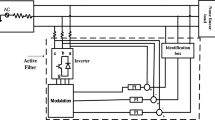Abstract
The primary focus of this work is on develo** a particle swarm optimisation (PSO)-based PI controller for a three-phase inverter-based active power filter with the intention of lowering harmonic distortion. In this project, inverter-based AF, namely shunt active power filter (SAPF), is used to mitigate the harmonics triggered by nonlinear loads/unbalanced loads in the source voltage and current by injecting the compensating currents. In order to reduce the severity of the harmonics and restore supply balance, the SAPF is recommended. For the suggested filter, the DC- link voltage is self-regulated using a PI controller, and its parameters are tweaked and improved with an intelligent approach called particle swarm optimisation (PSO). When it comes to nonlinear optimisation issues, PSO is one of the most popular solutions. The triggering pulses for the IGBT in the inverter are generated by a hysteresis current regulator, which is also a part of the system.
Access this chapter
Tax calculation will be finalised at checkout
Purchases are for personal use only
Similar content being viewed by others
References
Essamudin AE, El-Sayed A-H, Abdul-Ghaffar HI (2015) Particle swarm optimization based tuning of PI controller for harmonic compensation of non-linear dynamic loads. In: Fourth international conference on advanced control circuits and systems, ACCS'015, Nov. 2015, Luxor, Egypt
Ebrahim EA, El-Sayed A-H, Abdul-Ghaffar HI (2016) Particle swarm optimization-based control of shunt active-power filter with both static and dynamic loads. J Electr Eng 16(1):1–12
El-Saady G, El-Sayed A-H, Ebrahim EA, AbdulGhaffar HI (2015) Harmonic compensation using on-line bacterial foraging optimization based three-phase active power filter. WSEAS Trans Power Syst 10:73–81
Rabelo RD, Lemos MV, Barbosa D (2012) Power system harmonics estimation using particle swarm optimization. In: IEEE world congress on computational intelligence, Brisbane, Australia, 10–15 June 2012, pp 1–6
Uzuka T, Hase S, Mochinaga Y (1996) A static voltage fluctuation compensator for AC electric railway using self-commutated inverter. J Electr Eng Jpn 117(3):1521–1528
Takeda M, Murakami S (1997) Development of a three-phase unbalanced voltage fluctuation compensating system using a self-commutated static VAR compensator. J Electr Eng Jpn 12(3):826–834
Kalantari M, Sadeghi MJ, Fazel SS, Farshad S (2010) Investigation of power factor behavior in AC railway system based on special traction transformers. J Electromagn Anal Appl 2:618–626
Sun J, Duan Y, **ong Y, Zhang B (2012) Study of reactive power compensation for high speed railway design. Energy Procedia Sci Direct 17(Part A):414–421; Dai NY, Lao KW, Wong M (2013) A hybrid railway power conditioner for traction power supply system. IEEE Trans Industr Electron 45(2):1326–1331
Natesan P, Madhusudanan G (2014) Compensation of power quality problems in traction power system using direct power compensator. Int J Innov Res Sci Eng Technol 3(3):277–280
Sangle SV, Reddy CHM (2015) An innovative topology for harmonics and unbalance compensation in electric traction system using direct power control technique. Int J Innov Res Sci Eng Technol 4(12):12213–12220
https://www.researchgate.net/publication/228559771_Power_Quality_Problems_and_New_Solutions
Igual R, Medrano C, Arcega FJ, Mantescu G (2018) Integral mathematical model of power quality disturbances. In: 2018 18th international conference on harmonics and quality of power (ICHQP), pp 1–6. https://doi.org/10.1109/ICHQP.2018.8378902
Deokar SA, Waghmare LM (2014) Integrated DWT–FFT approach for detection and classification of power quality disturbances. Electr Power Energy Syst 61:594–605
Decanini JGMS, Tonelli-Neto MS, Malange FCV, Minussi CR (2011) Detection and classification of voltage disturbances using a fuzzy-ARTMAP-wavelet network. Electr Power Syst Res 81:2057–2065
Naderian S, Salemnia A (2016) An implementation of type‐2 fuzzy kernel based support vector machine algorithm for power quality events classification. Int Trans Electr Energy Syst 27(5)
Borges FAS, Fernandes RAS, Silva IN, Silva CBS (2016) Feature extraction and power quality disturbances classification using smart meters signals. IEEE Trans Industr Inform 12(2)
Abdoos AA, Mianaei PK, Ghadikolaei MR (2016) Combined VMD-SVM based feature selection method for classification of power quality events. Appl Soft Comput 38(C):637–646
Moravej Z, Pazoki M, Abdoos AA (2011) Wavelet transform and multi-class relevance vector machines based recognition and classification of power quality disturbances. Euro Trans Electr Power 21:212–222
Pahasa J, Ngamroo I (2012) PSO based kernel principal component analysis and multi-class support vector machine for power quality problem classification. Int J Innov Comput Inf Control 8(3A)
Lee CY, Shen YX (2011) Optimal feature selection for power-quality disturbances classification. IEEE Trans Power Del 26(4)
Hooshmand R, Enshaee A (2010) Detection and classification of single and combined power quality disturbances using fuzzy systems oriented by particle swarm optimization algorithm. Electr Power Syst Res 80:1552–1561
Kanirajan P, Kumar VS (2015) Power quality disturbance detection and classification using wavelet and RBFNN. Appl Soft Comput 35:470–481
Kubendran AKP, Loganathan AK (2017) Detection and classification of complex power quality disturbances using S-transform amplitude matrix–based decision tree for different noise levels. Int Trans Electr Energ Syst 27:e2286
Author information
Authors and Affiliations
Corresponding author
Editor information
Editors and Affiliations
Rights and permissions
Copyright information
© 2024 The Author(s), under exclusive license to Springer Nature Singapore Pte Ltd.
About this paper
Cite this paper
Dhulsingh, G., Lakshmi Swarupa, M. (2024). Power Quality Enhancement with PSO-Based Optimisation of PI-Based Controller for Active Power Filter. In: Gunjan, V.K., Kumar, A., Zurada, J.M., Singh, S.N. (eds) Computational Intelligence in Machine Learning. ICCIML 2022. Lecture Notes in Electrical Engineering, vol 1106. Springer, Singapore. https://doi.org/10.1007/978-981-99-7954-7_9
Download citation
DOI: https://doi.org/10.1007/978-981-99-7954-7_9
Published:
Publisher Name: Springer, Singapore
Print ISBN: 978-981-99-7953-0
Online ISBN: 978-981-99-7954-7
eBook Packages: Intelligent Technologies and RoboticsIntelligent Technologies and Robotics (R0)




